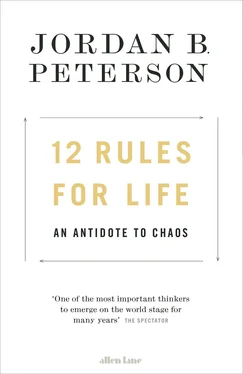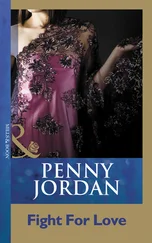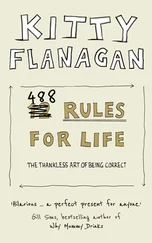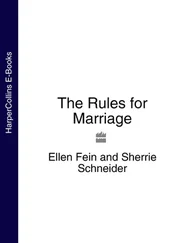The personalities we have evolved to perceive have been around, in predictable form, and in typical, hierarchical configurations, forever, for all intents and purposes. They have been male or female, for example, for a billion years. That’s a long time. The division of life into its twin sexes occurred before the evolution of multi-cellular animals. It was in a still-respectable one-fifth of that time that mammals, who take extensive care of their young, emerged. Thus, the category of “parent” and/or “child” has been around for 200 million years. That’s longer than birds have existed. That’s longer than flowers have grown. It’s not a billion years, but it’s still a very long time. It’s plenty long enough for male and female and parent and child to serve as vital and fundamental parts of the environment to which we have adapted. This means that male and female and parent and child are categories, for us—natural categories, deeply embedded in our perceptual, emotional and motivational structures.
Our brains are deeply social. Other creatures (particularly, other humans) were crucially important to us as we lived, mated and evolved. Those creatures were literally our natural habitat—our environment. From a Darwinian perspective, nature—reality itself; the environment, itself—is what selects . The environment cannot be defined in any more fundamental manner. It is not mere inert matter. Reality itself is whatever we contend with when we are striving to survive and reproduce. A lot of that is other beings, their opinions of us, and their communities. And that’s that.
Over the millennia, as our brain capacity increased and we developed curiosity to spare, we became increasingly aware of and curious about the nature of the world—what we eventually conceptualized as the objective world—outside the personalities of family and troupe. And “outside” is not merely unexplored physical territory. Outside is outside of what we currently understand—and understanding is dealing with and coping with and not merely representing objectively . But our brains had been long concentrating on other people. Thus, it appears that we first began to perceive the unknown, chaotic, non-human world with the innate categories of our social brain. [18036] I would also most highly recommend, in this regard, this book by C.G. Jung’s most outstanding student/colleague, Neumann, E. (1955). The Great Mother: An analysis of the archetype . Princeton, NJ: Princeton University Press.
And even this is a misstatement: when we first began to perceive the unknown, chaotic, non-animal world, we used categories that had originally evolved to represent the pre-human animal social world . Our minds are far older than mere humanity. Our categories are far older than our species. Our most basic category—as old, in some sense, as the sexual act itself—appears to be that of sex, male and female. We appear to have taken that primordial knowledge of structured, creative opposition and begun to interpret everything through its lens. [18037] https://www.dol.gov/wb/stats/occ_gender_share_em_1020_txt.htm
Order, the known, appears symbolically associated with masculinity (as illustrated in the aforementioned yang of the Taoist yin-yang symbol). This is perhaps because the primary hierarchical structure of human society is masculine, as it is among most animals, including the chimpanzees who are our closest genetic and, arguably, behavioural match. It is because men are and throughout history have been the builders of towns and cities, the engineers, stonemasons, bricklayers, and lumberjacks, the operators of heavy machinery. [18038] Muller, M.N., Kalhenberg, S.M., Thompson, M.E. & Wrangham, R.W. (2007). “Male coercion and the costs of promiscuous mating for female chimpanzees.” Proceedings of the Royal Society (B), 274 , 1009-1014.
Order is God the Father, the eternal Judge, ledger-keeper and dispenser of rewards and punishments. Order is the peacetime army of policemen and soldiers. It’s the political culture, the corporate environment, and the system. It’s the “they” in “you know what they say.” It’s credit cards, classrooms, supermarket checkout lineups, turn-taking, traffic lights, and the familiar routes of daily commuters. Order, when pushed too far, when imbalanced, can also manifest itself destructively and terribly. It does so as the forced migration, the concentration camp, and the soul-devouring uniformity of the goose-step.
Chaos—the unknown—is symbolically associated with the feminine. This is partly because all the things we have come to know were born, originally, of the unknown, just as all beings we encounter were born of mothers. Chaos is mater , origin, source, mother; materia , the substance from which all things are made. It is also what matters , or what is the matter —the very subject matter of thought and communication. In its positive guise, chaos is possibility itself, the source of ideas, the mysterious realm of gestation and birth. As a negative force, it’s the impenetrable darkness of a cave and the accident by the side of the road. It’s the mother grizzly, all compassion to her cubs, who marks you as potential predator and tears you to pieces.
Chaos, the eternal feminine, is also the crushing force of sexual selection. Women are choosy maters (unlike female chimps, their closest animal counterparts [18039] For a host of interesting statistics derived from the analysis of his dating site, OkCupid, see Rudder, C. (2015). Dataclysm: Love, sex, race & identity . New York: Broadway Books. It is also the case on such sites that a tiny minority of individuals get the vast majority of interested inquiries (another example of the Pareto distribution).
). Most men do not meet female human standards. It is for this reason that women on dating sites rate 85 percent of men as below average in attractiveness. [18040] Wilder, J.A., Mobasher, Z. & Hammer, M.F. (2004). “Genetic evidence for unequal effective population sizes of human females and males.” Molecular Biology and Evolution, 21 , 2047-2057.
It is for this reason that we all have twice as many female ancestors as male (imagine that all the women who have ever lived have averaged one child. Now imagine that half the men who have ever lived have fathered two children, if they had any, while the other half fathered none). [18041] Miller, G. (2001). The mating mind: How sexual choice shaped the evolution of human nature. New York: Anchor.
It is Woman as Nature who looks at half of all men and says, “No!” For the men, that’s a direct encounter with chaos, and it occurs with devastating force every time they are turned down for a date. Human female choosiness is also why we are very different from the common ancestor we shared with our chimpanzee cousins, while the latter are very much the same. Women’s proclivity to say no, more than any other force, has shaped our evolution into the creative, industrious, upright, large-brained (competitive, aggressive, domineering) creatures that we are. [18042] Pettis, J. B. (2010). “Androgyny BT.” In D. A. Leeming, K. Madden, & S. Marlan (Eds.). Encyclopedia of psychology and religion (pp. 35-36). Boston, MA: Springer US.
It is Nature as Woman who says, “Well, bucko, you’re good enough for a friend, but my experience of you so far has not indicated the suitability of your genetic material for continued propagation.”
The most profound religious symbols rely for their power in large part on this underlying fundamentally bipartisan conceptual subdivision. The Star of David is, for example, the downward pointing triangle of femininity and the upward pointing triangle of the male. [11891] It is of great interest, in this regard, that the five-part taijitu (referred to in Chapter 1 and the source of the simpler yin/yang symbol) expresses the origin of the cosmos as, first, originating in the undifferentiated absolute, then dividing into yin and yang (chaos/order, feminine/masculine), and then into the five agents (wood, fire, earth, metal, water) and then, simply put, “the ten thousand things.” The Star of David (chaos/order, feminine/masculine) gives rise in the same way to the four basic elements: fire, air, water and earth (out of which everything else is built). A similar hexagram is used by the Hindus. The downward triangle symbolizes Shakti, the feminine; the upward triangle, Shiva, the masculine. The two components are known as om and hrim in Sanskrit. Remarkable examples of conceptual parallelism.
It’s the same for the yoni and lingam of Hinduism (which come covered with snakes, our ancient adversaries and provocateurs: the Shiva Linga is depicted with snake deities called the Nagas). The ancient Egyptians represented Osiris, god of the state, and Isis, goddess of the underworld, as twin cobras with their tails knotted together. The same symbol was used in China to portray Fuxi and Nuwa, creators of humanity and of writing. The representations in Christianity are less abstract, more like personalities, but the familiar Western images of the Virgin Mary with the Christ Child and the Pietà both express the female/male dual unity, as does the traditional insistence on the androgyny of Christ. [18043] Goldberg, E. (2003). The executive brain: Frontal lobes and the civilized mind . New York: Oxford University Press.
Читать дальше












